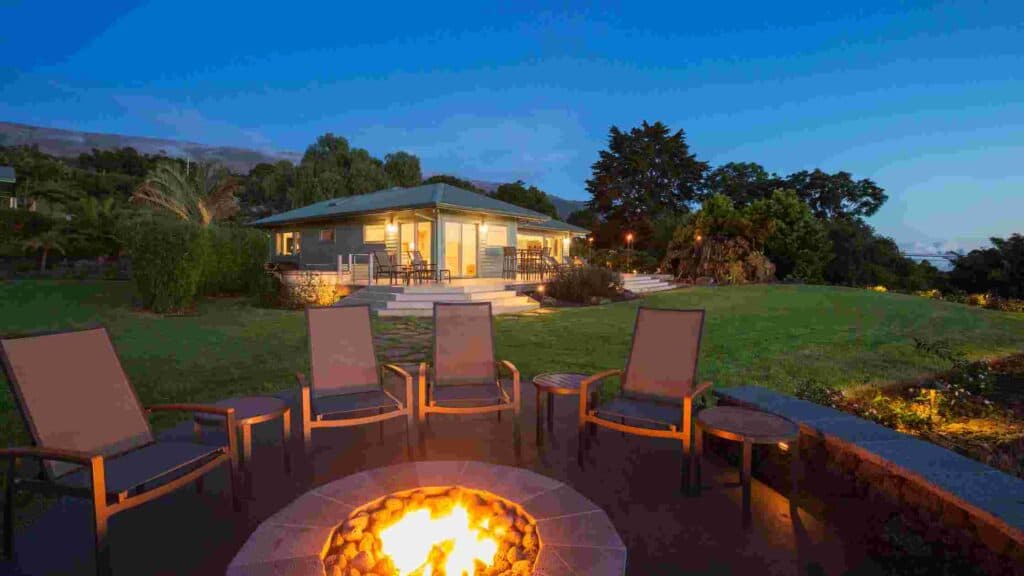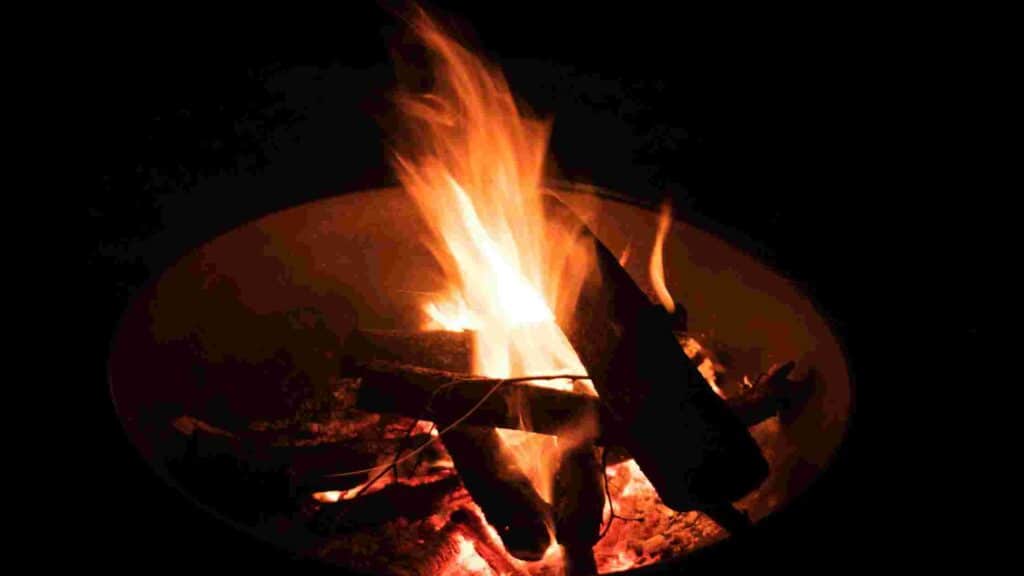When the crispness of autumn fills the air and you find yourself basking in the warm glow of a delicious grilled dinner, it’s natural to want the evening to linger. As you savor the company and the ambiance, you may have a question in mind: Can you light a fire in your own backyard without getting into trouble with the law?
So, let’s delve into the details and explore the legalities and safety considerations surrounding backyard fires, ensuring you stay on the right side of the flame if you decide to ignite one.
Can You Light A Fire In Your Backyard?
Local ordinances wield significant influence over the permissibility of backyard fires, with population density being a crucial factor (also check out: Can you have a fire in your backyard?)
In densely populated areas, the potential for property damage and harm to human lives increases exponentially. Even in rural or suburban locales, you might discover that building a fire in your backyard is a definite no-no.
It’s imperative to consider the rules set forth by your homeowners’ association, as they may explicitly prohibit such activities. In some cases, obtaining a permit, which often incurs a fee, maybe a prerequisite for setting ablaze.
2. Outdoor Burning Regulations – Are Backyard Fires Allowed?

When it comes to the federal government, the answer is “yes.” Lighting a fire in your backyard is generally permissible, as long as it’s done responsibly.
After all, fire is no laughing matter, as evidenced by the sobering statistics from the Consumer Product Safety Commission. Approximately 6,200 individuals were sent to the emergency room in 2021 due to injuries associated with fire pits or outdoor heaters.
However, the stance of state governments can differ significantly. Certain regions, like Arizona and Colorado, explicitly prohibit backyard fires for both recreational and trash-burning purposes. These restrictions often revolve around air quality concerns. For instance, temperature inversions can trap hazardous fumes in lower areas, posing a severe health risk.
Additionally, factors such as wildfires in neighboring regions, general pollution, and designated “No Burn Days” may impact your ability to safely light a fire in your backyard (here’s a guide on how to light a gas fire pit).
3. The Importance Of Wood Sources
In the realm of backyard fires, the source of your firewood is equally critical. When venturing into state or county parks, you may notice signs prohibiting the use of wood sourced from outside the area or within a specified radius.
These restrictions stem from the threat posed by pests like the emerald ash borer. These destructive insects invaded the United States in 2002 and have the potential to decimate ash tree populations.
Consequently, regulations exist to prevent the introduction of infested wood into your state or county. Some areas may only permit the use of heat-treated wood to ensure these pests are eradicated.
Given the wide variation in laws and regulations, it’s advisable to conduct thorough research and verify the requirements before sourcing firewood from any location. Respecting and preserving the environment should always be a priority.
4. What To Burn And What To Avoid
Assuming your city allows backyard fires, it’s crucial to discern what materials can and cannot be burned. Certain substances should never find their way into your fire pit due to their potential hazards.
Among the items to avoid burning are household trash, particularly styrofoam, plastics, and cardboard, which can release toxic fumes when incinerated. Additionally, unseasoned and green wood, poison ivy, and construction scraps should be strictly off-limits.
Not only do these materials emit harmful substances, but they can also produce copious amounts of smoke, which can be detrimental to individuals with respiratory conditions such as COPD or asthma.
Essential Tips For Fire Safety

If you’ve made the decision to kindle a fire in your yard, it’s vital to take precautionary measures before striking that first match.
Let’s delve into some key tips to ensure a safe and enjoyable experience.
1. Choosing The Right Location
When selecting the ideal spot for your fire, ensure it is situated at least 10 feet away from any buildings or flammable objects, including your own house. We’ve covered this in detail here: how far should a fire pit be from a house?
It’s crucial to verify if there are any specific requirements or restrictions in your area regarding fire placement. Opting for a fire pit is a wise choice as it provides containment and minimizes risks compared to open fire on bare ground (here are some in-ground fire pit ideas).
2. Considering Weather And Wind
The weather and wind conditions play a crucial role in containing your backyard fire.
Before igniting, check the wind speed and direction. Ideally, the wind should be between 4 and 15 mph, blowing away from neighboring houses. This range ensures a sufficient breeze to disperse smoke without creating a fire hazard.
Additionally, choose a day with relative humidity between 30 and 60 percent. Extremely low humidity can dry out the surroundings of your fire, increasing the risk of it spreading and getting out of control.
Conversely, excessively high humidity may hinder proper burning, resulting in smoldering rather than a vibrant fire. Striking a balance is key for an enjoyable and functional fire experience.
To stay informed, consult the weather forecast on your smartphone. Certain areas may issue fire bans during dangerous wildfire conditions. If there is an advisory or warning, it’s best to postpone your fire plans to a day when conditions are more favorable.
Some regions may require advance notification of a fire, particularly if it could affect visibility on nearby roads. If you obtained a permit, you may have a specific timeframe for your fire.
As a courtesy, it’s always wise to inform your neighbors of your plans, promoting good relations and a harmonious neighborhood environment.
3. Setting The Stage
Using permitted, seasoned, and dry wood is essential to maintain a controlled and safe fire. Kindling is also necessary to ignite the flames, making an ax a handy tool for preparing the firewood.
Equipping yourself with a garden hose and a shovel acts as a precautionary measure and allows you to extinguish the fire when you’re ready to retreat indoors.
Additionally, having the appropriate tools to manage and control the fire, along with a nearby fire extinguisher, is highly recommended.
We strongly advise against using lighter fluid to ignite the fire (read how to start a fire in a fire pit).
Instead, consider acquiring fire starters available online or at your local camping store, which provide a safer and more convenient alternative. With enough kindling and proper preparation, you should have no trouble getting your fire started.
FAQs – Can You Light Fires In Your Backyard?
1. What can I do about neighbors’ fire pit smoke?
If you’re experiencing issues with smoke from your neighbor’s fire pit, you can try discussing the matter with them politely and expressing your concerns.
You may also consider installing barriers or using windbreaks to minimize the impact of the smoke in your yard. Consulting local regulations or homeowner’s association guidelines can provide additional guidance on resolving the issue.
2. Can you light a fire pit on grass?
Lighting a fire pit on grass is generally not recommended, as it poses a fire hazard. It’s preferable to place the fire pit on a non-combustible surface such as gravel, concrete, or patio stones to prevent the fire from spreading to the surrounding grass.
3. Can you light a fire in your garden?
It depends on local regulations and any fire restrictions that may be in place. Before lighting a fire in your garden, check with your local authorities or fire department to ensure that it is allowed and follow any guidelines or permits that may be required.
Safety precautions, such as keeping the fire contained and having appropriate fire safety equipment nearby, should always be followed.
Conclusion: Can You Light A Fire In Your Backyard?
While the allure of gathering around a crackling campfire to bask in its warmth and create cherished memories with loved ones is undeniable, it’s essential to address the question of whether you can light a fire in your backyard before commencing. You may also be interested in checking out: Can I have a fire pit in my backyard?
By seeking proper permissions and adhering to safety guidelines, you can ensure a hassle-free experience and focus on relishing the cozy ambiance.
Remember, the goal is to create an enjoyable atmosphere, not to invite fines or jeopardize anyone’s well-being.
